One of my all time favorite fish is salmon. It’s rich, fatty and loaded with nutrition like the essential fatty acids EPA & DHA (omega-3s), B-vitamins, potassium, selenium and more.
However, we must remember that food & the nutrition in it is only as good as it’s source (how it’s raised, how it’s grown, etc).
When looking for a salmon source, or really, any fish source, I always recommend trying to find a wild-caught source versus a “farmed” version. Here’s one main reason why:
Many factory farmed fisheries are much like land animal factory farms (CAFO) – usually fed unnatural diet of grain & legume (corn, soy, etc. and likely GMO), given antibiotics, growth promotents, and more. Fish aren’t designed to eat this stuff, they never have in the whole history of, well, fish…when’s the last time we saw a corn plant growing in the ocean and a fish eating corn on the cob from it?
We haven’t, ever.
It would be like if I fed you processed junk food or fast food all your life…you’re not designed to eat that stuff, right? Let alone all your life? And what do you think your state of health would be like if you ate junk food every day of your life… optimal health? or poor health?
Same goes for the fish (or any animal) that eats an unnatural diet and lives an unnatural lifestyle, that we at the top of the food chain ultimately eats; and as we know, we are what we eat, we are how it’s grown and we are how it’s raised.
Here’s some more things you should know about farmed fish.
Since we’re on the topic of Salmon, I should add we also have GMO salmon in the pipeline to be approved by the FDA. According to FoodandWaterWatch.org, “the biotechnology industry says it has genetically modified a fish that grows at twice the normal rate, so it can get to market sooner and make more money, faster. But this dangerous lab experiment is all hype and full of downsides to consumers, salmon growers and the environment”. More so, a Canadian risk assessment conducted by Canadian government scientists refute the FDA and found that GMO salmon are susceptible to disease.
Remember, food industry is just that, industry. With Big Food, it’s all about business and “the bottom line”, not health. The bigger and more fish produced to maximize X amount of fish farm space = more $ per unit (and thus profits) when fish are ready to go to processing, then shipping, and finally ending up in our major grocery stores that we then buy and eat (this includes fresh fish at the fish counter and frozen fish).
I’m even a bit weary of the “responsibly farmed” fish signs we can find at Whole Foods… however I will eat it if I know the farming practices and wild-caught fish is not available. Whole Foods seems to be fairly transparent so you can decide, but that doesn’t mean all fish farms are when we see a “responsibly farmed” or “sustainably farmed” sign. Both those terms, “responsible” and “sustainable”, actually carry no legal meaning in terms of labels (much like how “natural” means nothing on a label and is often used by Big Food to portray a positive perception to the consumer).
As I always say, “Know your farmer, so you know your food” (i.e. ask questions and find out how produce was grown and animals were raised, including fish in fish farms).
For this recipe, I used wild-caught Alaskan salmon I got at my local fish market. In terms of integrity source, it’s one of the best we can eat.
Overall this caramelized maple salmon salad is recipe-friendly:
- Paleo
- Vegetarian (pesco)
- ReBoot Protocol Week 2+ (see Kitchen Notes below for serving)
- Gluten & Grain-free
- Dairy-free
- 100% Real Food ingredients
Let’s “dive” in..
INGREDIENTS
Servings: about 4-6
1 1/2 lbs. wild-caught salmon
8 cups mixed greens (approximate, you can use as much as you prefer. I actual never measure greens, we’re not baking here so it doesn’t need to be rocket science. Simple way I do it is 1 BIG and wide handful of greens for each salad serving)
2 mango, peeled, pitted & cubed
1 large avocado (or 2 medium), peeled, pitted & cubed
1 cup cilantro, leaves removed from stems
2 tablespoon olive oil
1 tablespoon pure maple syrup
1 tablespoon dijon-style mustard
Salad Dressing:
3 tablespoon olive oil
1 tablespoon pure maple syrup
1 tablespoon dijon-style mustard
1/2 tablespoon lemon juice, fresh squeezed
Small pinch each of pink salt, pepper & garlic powder
KITCHEN NOTES
1. This recipe is very versatile:
- You can make the salmon on it’s own as a main course or meal prep if you don’t want the salad, and then include any sides you like with salmon (potatoes, mixed veggies, etc.). The salmon by itself was epic good! If you don’t like salad, definitely try the salmon on its own.
- Make the salad on it’s own without the salmon (ReBoot week 1-friendly) and have as a side salad to a main course.
- Make the dressing on it’s own if you’re looking for a new tasty salad dressing idea.
2. ReBoot serving size: 1 – 1 1/2 tablespoons of dressing per meal. See your how-to manual for fish serving size.
3. Meal Prep: the salmon is a great meal prep so you have individual big chunk servings (see picture below) for your meals during the week. Salad dressing you can also double or triple up and keep a mason jar full in the fridge for easy ready-made salad dressing for your week.
Click Here to Pin for Later!
METHOD
1. Preheat a skillet on your stove to medium heat.
2. While skillet warming up, we’ll do our fish marinade: whisk the 1 tablespoon of mustard and 1 tablespoon of maple syrup in a bowl until all combined.
3. Add your salmon to a plate and pour the maple-mustard marinade on it, rubbing it all over so it’s evenly coated on all surfaces (if your salmon has skin, rub most of it on non-skin top and side surfaces).
4. Add 2 tablespoon of olive oil to the heated pan.
5. Add your salmon and we’re going to let it sizzle for 3 minutes on the bottom (skin side if you have it) and then flip it and 3 minutes on the top, for 6 total minutes.
- Salmon with skin: this 6 total minutes will give it a medium-rare middle how I like it (if you like your salmon more cooked, cook it longer to your liking but I wouldn’t go more than 4 minutes per side).
- Salmon without skin: a bit more cooked to medium since we don’t have skin on one side, so adjust accordingly if you want to.
Note: once you place the fish in the pan, don’t move it until you have to flip it. This will help create the nice caramelized color from the maple sugars on it (see pictures in post).
6. After it’s done, remove to a plate and let it rest (5-10 minutes or so: it will slowly cook a little longer) while we prep the rest of our salad ingredients.
7. During this resting period, prep:
- lettuce: add to a big bowl
- avocado: peel, remove pit, slice and cube
- mango: peel, carefully slice around pit, and cube
- cilantro: simply pick leaves off stem
- dressing: place all dressing ingredients in a blender and blend until everything incorporated. Give it a quick taste for salt and pepper if satisfactory to your palate.
8. Add everything to the lettuce bowl (except salmon) and toss with some dressing so everything is coated. Remove skin from salmon if you have it.
9. Plate salad and add a beautiful piece of the caramelized salmon to the top (see image below) or if you’re serving to your family or group of people, plate all salad on a platter and flake big chunks throughout the platter (see image above).
Individual plated salad
Questions? Ask below in the comments!


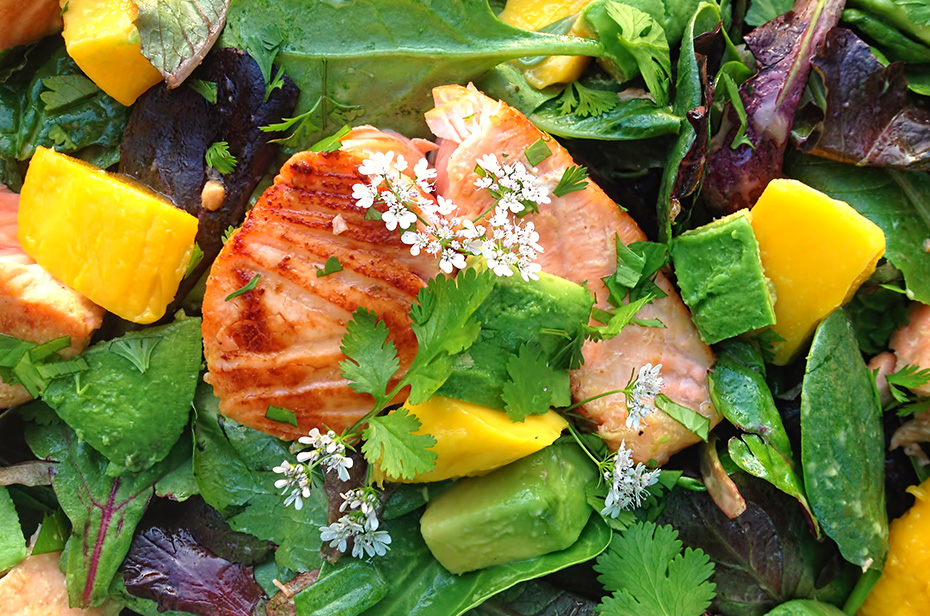
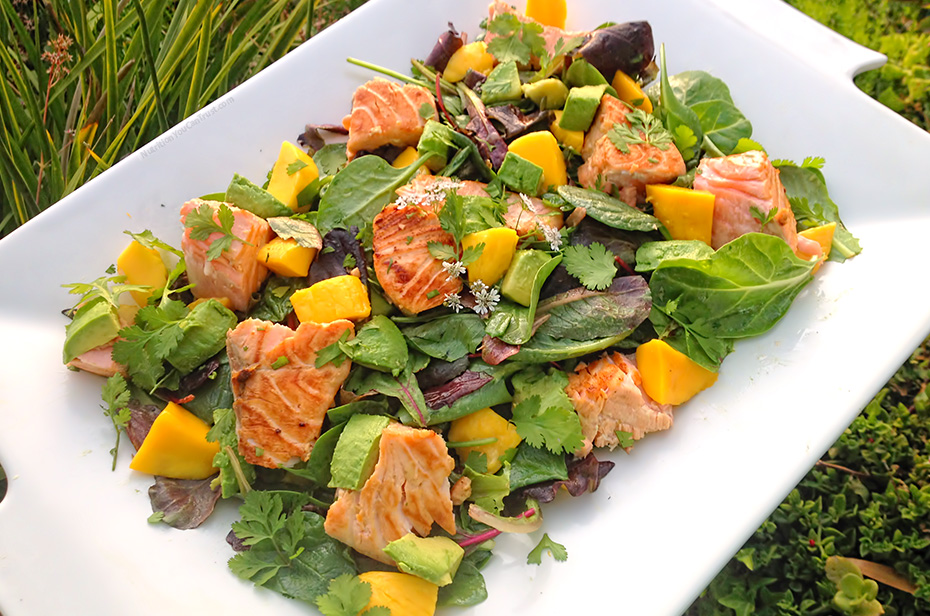
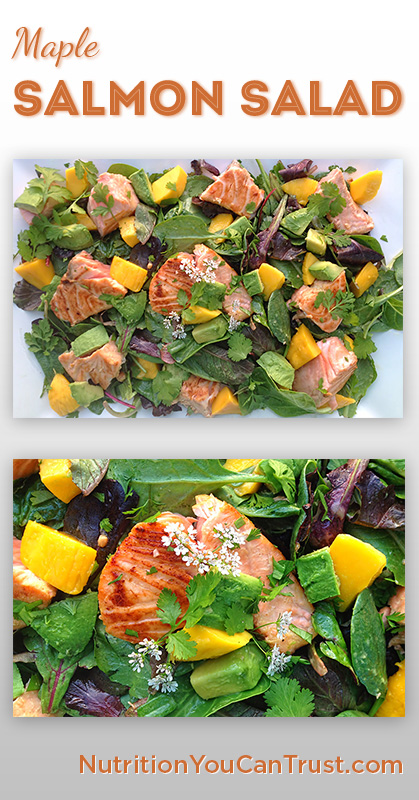
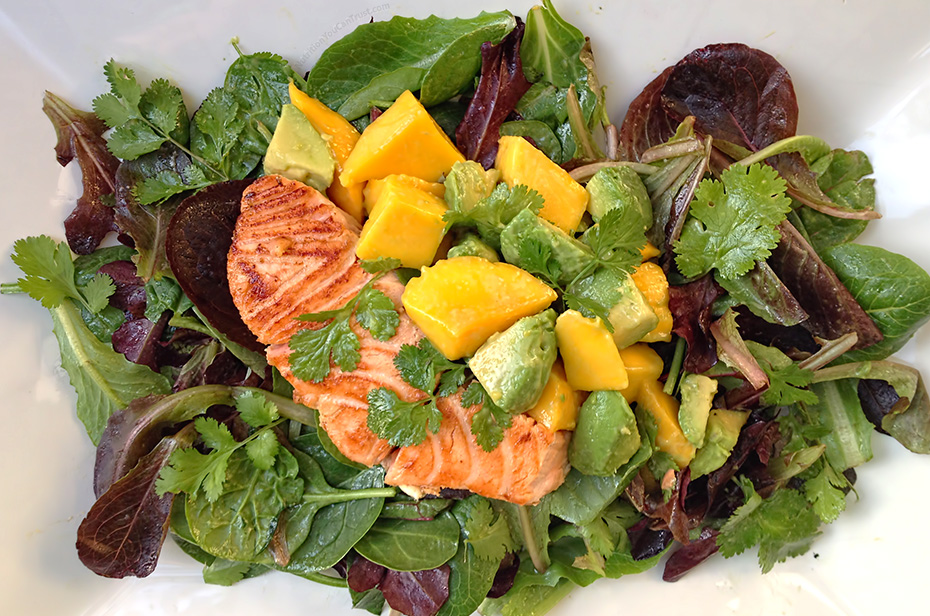







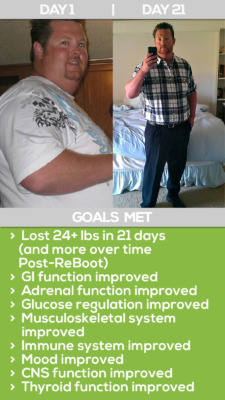




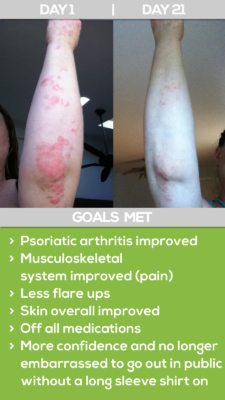



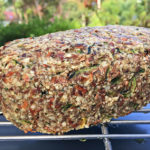


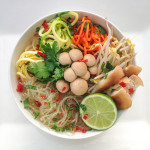
Yummy!
Cheers Bree
Wow this got me salivating! The maple with the salmon sounds so good
The maple-mustard is so simple and effective. works great. Thanks Jennifer
Nailed it bro. Looks great.
thanks my man
Jon! Looking at this makes me want to Reboot again lol. I’m going to email you!!
haha sounds good Nicole.. we’ll get you taken care of
Good morning Jon,
This looks really good. I have a question: I have some tilapia to use so I wanted to adapt this recipe for it, do you think it will work?
Hi Janelle, should work just fine. I’ve done the maple-mustard marinade on different fish. Enjoy!